| Chromodorididae | |
|---|---|

| |
| Doriprismatica atromarginata | |
| Scientific classification | |
| Domain: | Eukaryota |
| Kingdom: | Animalia |
| Phylum: | Mollusca |
| Class: | Gastropoda |
| Order: | Nudibranchia |
| Superfamily: | Doridoidea |
| Family: | Chromodorididae Bergh, 1891 |
| Type genus | |
| Chromodoris | |
| Genera | |
|
See text | |
| Synonyms | |
| |
Chromodorididae, or chromodorids, are a taxonomic family of colourful sea slugs; dorid nudibranchs, marine gastropod mollusks in the superfamily Doridoidea. “Chromodorid nudibranchs are among the most gorgeously coloured of all animals.” The over 360 described species are primarily found in tropical and subtropical waters, as members of coral reef communities, specifically associated with their sponge prey. The chromodorids are the most speciose family of opisthobranchs. They range in size from <10mm to over 30 cm, although most species are approximately 15–30 mm in size.
Although, they have a worldwide distribution, most species are found in the Indo-Pacific region. A scientific paper published in 2007, found the most widespread chromodorid genera, (Mexichromis, Chromodoris, Glossodoris and Hypselodoris) to be paraphyletic or polyphyletic.
The family Cadlinidae Bergh, 1891 has been considered a synonym of the Chromodorididae. Research by R.F. Johnson in 2011 has shown that Cadlina does not belong to the family Chromodorididae. She has therefore brought back the name Cadlinidae from synonymy with Chromodorididae. The chromodorid nudibranchs without Cadlina are now monophyletic and turn out to be a possible sister to the family Actinocyclidae. Cadlina and Aldisa are the only two genera currently classified in the Cadlinidae.
A comprehensive phylogeny of the chromodorid nudibranchs found every one of the 14 traditional chromodorid genera were either non-monophyletic, or rendered another genus paraphyletic. Additionally, both the monotypic genera Verconia and Diversidoris are nested within clades. The authors presented a new classification of the chromodorid nudibranchs, which used molecular data to untangle evolutionary relationships and at the same time retains a historical connection to traditional systematics by using generic names attached to type species as clade names. All Chromodorid nudibranchs feed on sponges.
Genera
Genera within the family Chromodorididae include:
- Ardeadoris Rudman, 1984
- Berlanguella Ortea, Bacallado & Valdés, 1992 (although this has not been properly investigated)
- Ceratosoma J. E. Gray and M. E. Gray, 1850
- Chromodoris Alder and Hancock, 1855 - the type genus
- Chromolaichma Bertsch, 1977
- Diversidoris Rudman, 1987
- Doriprismatica d'Orbigny, 1839
- Felimare Ev. Marcus & Er. Marcus, 1967
- Felimida Marcus, 1971
- Glossodoris Ehrenberg, 1831
- Goniobranchus Pease, 1866
- Hypselodoris Stimpson, 1855
- Mexichromis Bertsch, 1977
- Miamira Bergh, 1874
- Thorunna Bergh, 1878
- Tyrinna Bergh, 1898
- Verconia Pruvot-Fol, 1931 - synonym: Noumea Risbec, 1928
- Genera brought into synonymy
- Actinodoris Ehrenberg, 1831 : synonym of Chromodoris Alder & Hancock, 1855
- Babaina Odhner in Franc, 1968 : synonym of Thorunna Bergh, 1878
- Casella H. Adams & A. Adams, 1854 : synonym of Glossodoris Ehrenberg, 1831
- Crepidodoris Pagenstecher, 1877 : synonym of Glossodoris Ehrenberg, 1831
- Digidentis Rudman, 1984 : synonym of Thorunna
- Durvilledoris Rudman, 1984 : synonym of Mexichromis
- Jeanrisbecia Franc, 1968 : synonym of Risbecia Odhner, 1934 synonym of Hypselodoris Stimpson, 1855
- Lissodoris Odhner, 1934 : synonym of Chromodoris Alder & Hancock, 1855
- Noumea (preoccupied by a beetle): synonym of Verconia
- Orodoris Bergh, 1875 : synonym of Ceratosoma Gray, 1850
- Pectenodoris Rudman, 1984 : synonym of Mexichromis
- Pterodoris Ehrenberg, 1831 : synonym of Hypselodoris Stimpson, 1855
- Risbecia Odhner, 1934 : synonym of Hypselodoris
- Rosodoris Pruvot-Fol, 1954 : synonym of Glossodoris Ehrenberg, 1831
-
 Ardeadoris cruenta
Ardeadoris cruenta
-
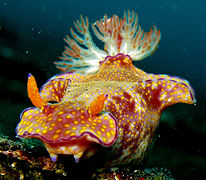 Ceratosoma tenue
Ceratosoma tenue
-
Chromodoris magnifica
-
 Diversidoris crocea
Diversidoris crocea
-
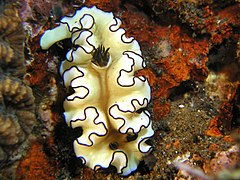 Doriprismatica atromarginata
Doriprismatica atromarginata
-
 Felimare cantabrica
Felimare cantabrica
-
 Felimida krohni
Felimida krohni
-
 Glossodoris cincta
Glossodoris cincta
-
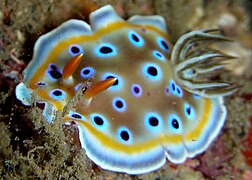 Goniobranchus geminus
Goniobranchus geminus
-
 Hypselodoris confetti
Hypselodoris confetti
-
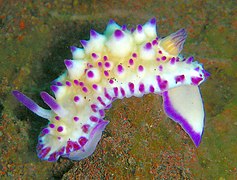 Mexichromis multituberculata
Mexichromis multituberculata
-
 Verconia norba
Verconia norba
-
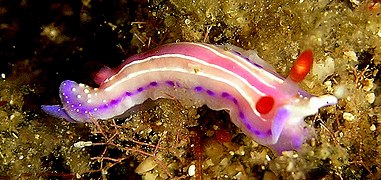 Thorunna australis
Thorunna australis
References
- ^ Bouchet, P. (2011-04-05). "Chromodorididae". WoRMS. World Register of Marine Species.
- ^ Bouchet, Philippe; Rocroi, Jean-Pierre; Frýda, Jiri; Hausdorf, Bernard; Ponder, Winston; Valdés, Ángel & Warén, Anders (2005). "Classification and nomenclator of gastropod families". Malacologia. 47 (1–2). Hackenheim, Germany: ConchBooks: 1–397. ISBN 3-925919-72-4. ISSN 0076-2997.
- Edmunds, M (1981). "Opisthobranchiate Mollusca from Ghana: Chromodorididae. Zoological Journal of the Linnean Society". 71: 175–201.
{{cite journal}}: Cite journal requires|journal=(help): “Chromodorid nudibranchs are among the most gorgeously colored of all animals.” - ^ Johnson, R.F.; Gosliner, T.M. (2012). "Traditional taxonomic groupings mask evolutionary history: A molecular phylogeny and new classification of the chromodorid nudibranchs". PLoS ONE. 7 (4): e33479. Bibcode:2012PLoSO...733479J. doi:10.1371/journal.pone.0033479. PMC 3323602. PMID 22506002.
- Gosliner, T.M.; Behrens, D.W.; Valdes, A. (2008). Indo-Pacific Nudibranchs and Sea Slugs: A field guide to the World's most diverse fauna. Sea Challengers Natural History Books and the California Academy of Sciences.
- Turner, LM; Wilson, NG (2008). "Polyphyly across oceans: a molecular phylogeny of the Chromodorididae (Mollusca, Nudibranchia)". Zoologica Scripta. 37: 23–42. doi:10.1111/j.1463-6409.2007.00310.x. S2CID 86754600.
- Rudman, W.B. (June 1984). "The Chromodorididae (Opisthobranchia: Mollusca) of the Indo-West Pacific: a review of the genera". Zoological Journal of the Linnean Society. 81 (2/3): 115–273. doi:10.1111/j.1096-3642.1984.tb01174.x.
- Johnson, R.F. (2011). "Breaking family ties: taxon sampling and molecular phylogeny of chromodorid nudibranchs (Mollusca, Gastropoda)". Zoologica Scripta. 40 (2): 137–157. doi:10.1111/j.1463-6409.2010.00457.x. S2CID 82123571.
- Rudman, W.B., 2007 (Jul 21) Review of chromodorid feeding. Sea Slug Forum. Australian Museum, Sydney.
- Rudman W.B. & Bergquist, P.R., 2007. A review of feeding specificity in the sponge-feeding Chromodorididae (Nudibranchia: Mollusca). Molluscan Research 27(2): 60–88.